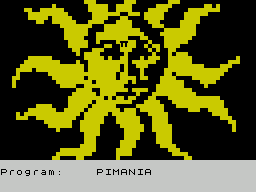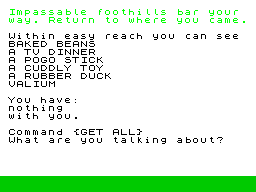Retro Replay Review
Gameplay
Pimania’s gameplay centers around exploration and puzzle-solving, tasking players with uncovering the whereabouts of the elusive Golden Sundial of Pi. From the moment you arrive in Piland, the game encourages experimentation: every object, every conversation, and every cryptic riddle could hold a piece of the greater mystery. This design fosters a deep sense of curiosity, driving you to systematically record clues and map out connections between disparate hints scattered across the landscape.
A unique element is the Piman, a quirky creature whose moods and preferences can both aid and obstruct your progress. Learning to read the Piman’s behavior becomes a mini-game unto itself—you’ll need to feed it the right items, avoid its pet peeves, and decipher its cryptic utterances. Successfully managing the Piman rewards you with vital intelligence, while missteps can set you back or force you to retrace your steps, adding a layer of dynamic interaction that keeps the core gameplay loop fresh.
Despite its age, Pimania strikes a balanced difficulty curve. Early puzzles act as a gentle introduction, but as you delve deeper into Piland, the challenges grow increasingly intricate. Some puzzles require lateral thinking around mathematical concepts—particularly the properties of π—while others rely on keen observation and note-taking. Although the Sundial itself doesn’t appear in the game, the journey to reconstruct its coordinates offers a satisfying intellectual workout and a rare blend of maths-infused adventuring.
Graphics
Pimania’s visuals embrace a minimalist aesthetic typical of late-1970s and early-1980s interactive titles. The world of Piland is rendered in simple line art and block colors, but the sparse presentation amplifies the game’s surreal atmosphere. Every vista—from crystalline caverns to winding pathways—feels otherworldly, as though you’re peering into a dreamscape governed by geometric logic.
While modern gamers may find the graphics rudimentary, there’s an undeniable charm in the game’s illustrative style. Icons representing key items or locations are clear and functional, ensuring you never lose track of objectives amid the game’s abstract setting. Occasional animations, like the Piman’s expressive gestures, inject personality into the otherwise static backdrops, reminding you that each environment is inhabited and alive.
On contemporary machines, emulator filters or scaled rendering can enhance visual clarity without sacrificing authenticity. This flexibility allows new players to experience Piland’s unique design through a nostalgic lens or with a smoother, more defined presentation. Either way, the graphics serve their purpose: to convey a bizarre, mathematically inspired realm that compels exploration above all else.
Story
At its core, Pimania weaves a deceptively simple narrative: you are an ordinary individual transported to the enigmatic land of Piland, tasked with uncovering the Golden Sundial of Pi. Yet beneath this straightforward premise lies a tapestry of riddles, mathematical lore, and eccentric characters that infuse the story with depth. The game never hands you a linear plot; instead, it invites you to piece together clues that hint at Piland’s hidden history and the Sundial’s intended power.
The role of the Piman elevates the storytelling by personifying Piland’s whimsy and unpredictability. This creature’s likes and dislikes aren’t mere gameplay mechanics—they’re narrative breadcrumbs. Each favorable gesture or sudden tantrum you witness from the Piman reveals a fragment of lore, sparking speculation about the creature’s origins and its connection to the Golden Sundial. Over time, you form an uneasy companionship that feels both playful and purpose-driven.
Although the Sundial itself exists only as a contest prize, the search for it becomes a story in its own right—a meta-adventure where the ultimate reward lies in mastering puzzles and outwitting cryptic guardians. The absence of a tangible final artifact in the game world reinforces the theme: knowledge and ingenuity are the real treasures. As you assemble the final coordinates, the narrative payoff resonates, offering a satisfying blend of intellectual triumph and mysterious closure.
Overall Experience
Pimania offers an experience that feels unlike most vintage or modern titles. It blends mathematical puzzle design with surreal storytelling, resulting in a game that appeals to adventurers, puzzle enthusiasts, and anyone intrigued by the interplay of logic and imagination. The journey through Piland is as memorable for its unexpected moments of humor—courtesy of the mercurial Piman—as it is for the mental challenge of decoding intricate clues.
The game’s pacing rewards patience and meticulous note-taking. Without hand-holding, you chart your own path, revisiting locations with fresh insight and reinterpreting earlier observations in light of new information. This self-driven exploration fosters a genuine sense of accomplishment, particularly when seemingly insurmountable puzzles yield to your deductive reasoning.
While Pimania may not boast flashy visuals or voice acting, its distinctive design and clever puzzle structure stand the test of time. For collectors of retro gaming experiences or those fascinated by early examples of interactive fiction and puzzle hybridization, Piland’s world is an unmissable odyssey. If you’re seeking a game that challenges your intellect, tickles your curiosity, and invites you into a delightfully odd realm, Pimania delivers an adventure you won’t soon forget.
 Retro Replay Retro Replay gaming reviews, news, emulation, geek stuff and more!
Retro Replay Retro Replay gaming reviews, news, emulation, geek stuff and more!









Reviews
There are no reviews yet.